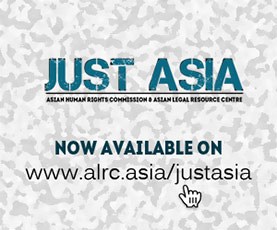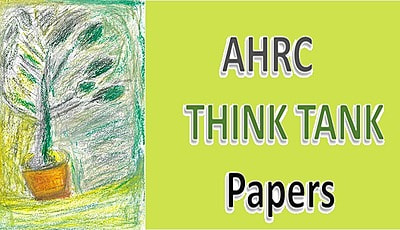SRI LANKA: AHRC and RCT collaboration
Appreciation on the occasion of the 30th anniversary of the RCT
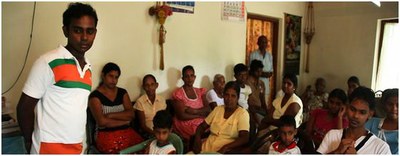
(Photo Courtesy: Janasansadaya)
On the occasion of the Rehabilitation and Research Centre for Torture Victims (RCT) celebrating its 30th Anniversary, the Asian Human Rights Commission (AHRC) wishes to record its appreciation for the RCT and recognize the contribution it has made to the development of the AHRC’s work relating to torture and ill-treatment. It is perhaps a happy coincidence that the meeting with parliamentarians, organized by the Asian Alliance against Torture and Ill-treatment, (AAATI) occurred in the same year. The AAATI emerged as a joint venture, started in 2011 and co-sponsored by the AHRC and RCT, after several years of collaboration, to develop a contextually relevant approach to dealing with the widespread use of torture and ill-treatment in Asian countries.
The AHRC and RCT collaboration, which started in Sri Lanka, has been a unique experience. Sri Lanka, in the period around the 1950s, was thought of as a rapidly emerging democracy and an example to the rest of Asia and Africa. The expectation was based on realistic estimations of social indicators, which showed remarkable achievements in the areas of reducing the child mortality rate, dramatic improvements of literacy and education levels, significant improvements in overall healthcare, and skill development in many fields.
However, this dream began to shatter in the late 1970s with the adoption of a constitutional model that placed all power on the executive president, thus displacing the judiciary and the parliament. This was accompanied by a wholesale experiment into the market economy with aggressive undermining of all aspects of welfare and severe attacks on the trade union movement. By around 2002, when the AHRC and RCT collaboration started, Sri Lanka’s rule of law system had suffered an exceptional collapse and grave abuses of human rights, by way of forced disappearances, extrajudicial killings, and the use of torture and ill-treatment, manifested a serious deterioration of public institutions in the country. Globally, this situation in Sri Lanka was misunderstood as a result of an ethnic crisis, which has developed into a military conflict between the LTTE and the Sri Lankan government.
The AHRC rejected this assessment of the Sri Lankan crisis as being purely based on the ethnic conflict, and instead described the crisis as one of a collapse of public institutions, giving rise to violence in many aspects of the country, including the conflict between the military and the LTTE. It was the view of the AHRC that this overall crisis, arising out of the authoritarian political model introduced by the 1978 constitution, needed to be highlighted as the fundamental cause of violence in Sri Lanka. The AHRC’s work on forced disappearances, torture and ill treatment has begun on the basis of these overall initiatives.
The AHRC concentrated on the exposure of torture and ill-treatment as taking place in all parts of Sri Lanka rather than as confined only to the record of violence in the North and East, which was the usual habit of other international organisations and most of the local organisations in Sri Lanka. It is the AHRC’s view that the totality of the crisis needs to be exposed if violence taking place in Sri Lanka is to find a comprehensive explanation, leading to the possibility of working towards the recovery of the rule of law system and the democratic institutions, which is the only real overall solution to the crisis. In addressing the crisis of the basic structure, the AHRC was of the view that exposure of police torture and ill-treatment, taking place in areas which were not the conflict areas, would lead to a clarification of the nature of the crisis in Sri Lanka.
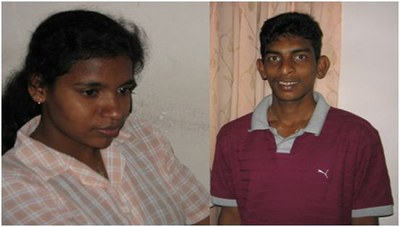
Jesudasan Rita and Lalth Rajapakse
Concentrating on police torture was the AHRC’s approach. It was this approach that the AHRC explained to the RCT and they agreed to a collaboration in terms of developing the prevention of torture project in Sri Lanka.
In the years that followed, this project encountered a large number of victims of torture, and the stories of their struggles are the most important aspect of this project. The number of victims is far too many to be mentioned individually. However, all of their cases are documented in detail and the documents have been published over and over again, and are available online and in various research publications. A few cases may be mentioned, cases that are quite well-known in Sri Lanka, and the lessons learned have become a part of the discourse on torture and ill-treatment in Sri Lanka.
There is the case of Lalith Rajapaksha, a seventeen-year-old boy, who was arrested and severely beaten all over his body, including on his head, on which books were placed and then hit with rods, resulting in his being unconscious for several weeks. The doctors identified his condition as edema on the brain, a condition that creates similar symptoms as encephalitis. The boy came from an extremely poor family and without very active support from human rights organisations he could not face up to the many problems that came as a result of this attack. He was continuously threatened by the police, who wanted him to withdraw his complaints. Dealing with this case led to very comprehensive ways of supporting torture victims, which combined protection of the victim for many years outside his home territory, community support to help him adjust to his new circumstances, a protracted legal struggle going from the Magistrates Courts to the High Court, to the Appeals Court, and finally to the United Nations Human Rights Committee. The UNHRC’s view expressed on this case, critiquing the delay in the adjudication process in Sri Lanka and issuing a recommendation for the adoption of legislative and judicial measures to ensure speedy justice, is by now referred to in several other cases. The incident happened in 2002 and the litigation still isn’t over. However, the victim was supported throughout this period and now he is living in stable conditions.
Another case is that of Rita Jesudasan, a fourteen-year-old girl from the poorest sections of Sri Lanka, from a family of tea estate workers, who was raped in 2001 while on her way to school by a youth from an affluent family in Kandy. As usual, the police were neglecting the investigation. It was at this stage that the Home for the Victims of Torture came to her assistance. She was given medical and psychological care and was also admitted to a school run by nuns. Her education for several years thereafter was taken care of by the Home for Victims of Torture and the most difficult part they faced was to support her in pursuing her case in the courts. She was determined to seek justice. However, when she went to court, she was insulted by the lawyer and others from the perpetrator’s side, who publicly shouted at her, calling her a prostitute. At this stage, a strategy was developed for a large number of persons from the community, including several nuns, to accompany her. There had been severe delays in the case as the perpetrators approached various authorities. She said that because she was a Tamil she was harassed at the police station and that initially they even refused to record her statement. Throughout her ordeal she was treated badly by the police when she tried to get her complaints registered. She had been subjected to humiliation and constant harassment.
Despite all these hazards, the case has continued for over ten years. Meanwhile, she has acquired skills and found employment. As of now, she is married and expecting her first child.
The next cases show the harsher side of fighting police torture.
The cases of Gerald Perera and Sugath Nishantha Fernando
Gerald Perera, a cook and a trade unionist, was arrested purely on mistaken identity. He was so harshly beaten that he suffered kidney failure and remained unconscious for nearly three weeks. Feeling deeply insulted and wounded, he was uncompromising in trying to seek justice. The Supreme Court of Sri Lanka gave a landmark judgment, in his favour, in a fundamental rights application and awarded the highest sum of compensation for torture so far. The Attorney General of Sri Lanka, in response to the Supreme Court judgment, filed an indictment under criminal charges under the CAT Act (Act No. 22 of 1994) against several police officers, and if the charges were proved they were subjected to a mandatory sentence of seven years rigorous imprisonment and a 10,000 rupees fine. A week before Gerald Perera was to give evidence in this trial he was fatally shot while travelling to work on a bus. Later, the first accused in the torture case, a police Sub Inspector, and one of his assistants, were charged for murder in this case. Both the cases of torture and murder are still continuing in the courts.
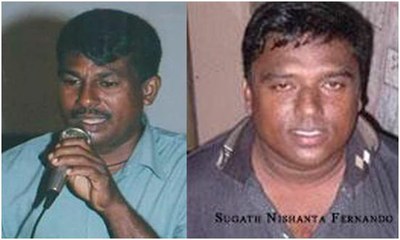
Gerald Perera and Sugath Nishantha Fernando
Sugath Nishantha Fernando was a businessman who bought a lorry from a police inspector and later found that the vehicle sold by the inspector was stolen. He complained about this matter to police authorities, as a result of which the inspector was dismissed from his position. Later, the authorities also pursued bribery charges against this police officer and some others. While this inquiry was proceeding, about 12 police came to his house and assaulted him, his wife, and their two children. He filed a fundamental rights application against police officers for the torture of his whole family. He was threatened, demanding that charges against the police officers be withdrawn. A short while later, he was fatally shot, in broad daylight, while sitting in his vehicle next to his son. To date, no inquiries have been conducted into this assassination. His wife was also threatened and pursued from place to place for several months because of her continued demands for inquiries. Finally, she and her children had to flee the country and now have obtained asylum in Europe.
The narratives of 323 cases of police torture from Sri Lanka were published by the AHRC in 2011.1
Working on these cases required the development of local organisations that could be easily accessed by the victims. Six such groups have emerged and established themselves in Sri Lanka, forming a hopefully permanent part of the human rights landscape within the country. These groups are Janasansadaya (Panadura), Home for Victims of Torture (Kandy), SETIK (Kandy), Right to Life (Negambo), Gampaha People’s Committee (Gampaha) and Rule of Law Forum (Colombo). All these organisations have now developed leaders with competence in human rights theory and practice, and have a firm commitment to fight against torture and ill-treatment with a comprehensive approach, combining assistance to victims in complaint making, pursuit of cases in the courts, trauma counseling, and other forms of psychological support. The most remarkable aspect of their development is in the documentation of all aspects relating to the redress and rehabilitation for victims of torture and ill-treatment. This documentation remains as a contribution to the study of the subject from many different points of view.
The work on this issue has led to a serious critique of Sri Lanka’s criminal justice system, beginning from the complaint mechanisms, investigation systems, prosecutions under the Attorney General’s department, and all aspects of adjudication. Heavily supported by detailed case studies, a solid argument has been developed on the need for radical reforms on policing, prosecutions and adjudication in Sri Lanka. In articles analyzing this aspect, the situation has been described as a dysfunctional system. Many articles and public speeches in many forums have been made on the subject and this analysis is now well known locally as well as internationally.
Understanding the psychological impact of torture and ill-treatment, and thereby helping the victims to deal with the psychological consequences of their torture, has been one of the major aims of this project. This issue has been pursued in many different ways. With the help of competent psychologists, there was training for the activists involved in this work. The training program helped some people to take a greater interest in the psychological assistance for victims. As a result, several counselors have emerged, some of who have academic qualifications in psychology. There are also para-psychologists, trained as counselors who attend to victims and, when necessary, they refer the victims to professional counselors. These activities have added to taking the work of torture beyond the area of a mere legal search for redress. One of the most important contributions in this area is the introduction of testimonial therapy. Professionals from the RCT have devoted considerable time to introduce this concept, helped with the training of local counselors, and also directly engage with victims in various stages of testimonial therapy. Now, this idea has been well understood by many counselors and the human rights activists themselves. Many victims who have participated in this activity have found the testimonial therapy quite useful. The gradual communication of their suffering with a large group of attentive individuals has helped them to understand themselves better and the publication of their private story to a larger community group has also helped them to deal with their problems better. It can be said without exaggeration that testimonial therapy has now been accepted as a quite useful tool and it is likely to remain part of the way torture and ill-treatment is dealt with in Sri Lanka.
The street movement against torture, ill-treatment and the failures of the criminal justice system in Sri Lanka is one of the more colourful activities that has developed as a result of this project. A large group of activists, with banners depicting various problems relating to the absence of justice and various recommendations on to deal with it, come to street junctions where large crowds usually move about. They remain on the pavements exhibiting the placards, talking to the passersby and also distributing leaflets and pamphlets. This practice has been repeated over and over again in many parts of the country. Often, former victims themselves come as volunteers to participate in this activity. Some groups have also extended this activity to house-to-house campaigns, where a group of victims and activists visit houses and encourage people to participate in the campaign against torture.
A further aspect of this project was the very active involvement of women in every facet of dealing with torture and ill-treatment. In all cases of torture, it is quite often the women who play the more active role in supporting the victims, including in community support groups, as well as in highlighting and fighting against the deep injustices that are the root causes of torture and ill-treatment. Quite often, women themselves are the direct victims. Women as victims of torture have shown remarkable resilience in continuing their fight, both for redress for themselves, as well as on the overall issue of exposing and fighting against the basic injustices involved in the relationship between the people and authorities, particularly the people and the police.
The project in Sri Lanka clearly demonstrates that almost all torture victims are from among the poorest sections of society. The very reason why they are selected for mistreatment by way of torture and ill-treatment is their defenseless situation in terms of their social power within society. Individuals from stronger social groups who have the capacity to protest and gain support from lawyers and the media are not subjected to this treatment due to the possible repercussions. It is often assumed that attacks on the poor will not lead to serious retaliation. What this project has demonstrated is that, when supported by human rights groups and community organisations, the poor retaliate against injustice as much as anyone else. In fact, the victims who have participated in this project have shown their capacity to withstand enormous pressures that come by way of harassments and threats, which are very often quite acute.
The working model developed in Sri Lanka2, regarding accountability and prevention of torture and ill-treatment has now been adopted in several countries in Asia. Several volumes from countries such as the Philippines, Bangladesh, Pakistan, Thailand, India, Indonesia, Myanmar, Cambodia and Nepal have been published on the basis of work done in these countries. The pattern emerging on police torture in all these countries has very close resemblances. It manifests as a policing system that relies on torture as the most important tool for investigations into crime. There is a quite open defence of torture and ill-treatment by the governments, police authorities, prosecutors, and even some judges, claiming that without the use of torture it is not possible to conduct effective criminal investigations.
In a remarkable thesis on Myanmar entitled, “Politics of Law and Order in Myanmar” Nick Cheesman, a long term colleague of the AHRC, describes the country’s criminal judicial system as a marketplace. The same description can be applied to the criminal justice systems in most countries in Asia. The all pervasive corruption turns arrest, detention, trial and everything that is associated with “justice” as things with which bargains can be made for the advantage of everyone except the citizens.
He notes, “As the object of the judicial process was the implementing of a specific policy agenda, the legal view of a case was only one factor in its final outcome: political, economic, social, and administrative viewpoints all had equal relevance. And because policy goals took precedence over strict legality, official exhortations to the systems functionaries had an increasingly administrative charter. Furthermore, these exhortations were backed by a coercive power over the judiciary that previous governments lacks.”
What the extensive work done in the prevention of torture project has taught us is that the international project on human rights, if it desires to achieve changes on the ground level in eliminating torture and ill-treatment, needs to approach the subject with a new understanding of the political, social, and legal realities of less developed countries, where torture and ill-treatment continues to remain quite widespread.
One of the most vigorous activities in this project has been in relation to the use of modern communication technologies for campaigning. All the activists in the project have been trained in the use of modern technology for fast communication. Daily, activists interview people at the grassroots level, faithfully take down their narratives, and communicate those narratives to their organisations. At each organisation, these narratives are rechecked and new interviews are conducted in order to complete the reports. Thereafter, the reports are written and communicated to the AHRC, based in Hong Kong. At the AHRC, Sri Lanka desk officers and the Urgent Appeals desk work together to check all facts and also to develop a readable narrative. This thereafter is communicated to the Urgent Appeals network through the AHRC, through e-mails, to a large number of people and organisations in Sri Lanka and abroad, including the media. In each case, letters are written to the Sri Lankan authorities and the UN agencies dealing with torture and ill-treatment. The narratives about torture are also supported by constant statements issued by the AHRC, which expresses views on the causes of torture and ill-treatment and advocates policies for change. The idea of such communications is to engage in public opinion making in favour of changes in all aspects that give rise to torture and ill-treatment. Periodically, these reports are collected and, with case illustrations, extensive analysis is published by the regular AHRC publications such as Article 2, a quarterly magazine, Ethics in Action, and also Torture: Asian and Global Perspectives. From time to time, books in English and in local languages are published, covering basic themes related to the rule of law and human rights protection. Besides these, with the use of video technology, local organisations publish stories directly told by the victims onto YouTube. From time to time, professional documentary filmmakers have also produced films on the basis of information gathered through this project.
It is to the great credit of the RCT that it open mindedly attempted to deal with torture and ill-treatment with the perspective to develop new knowledge about the objective conditions that produce such abuses, and to find ways to support victims who had virtually no support from state agencies, while at the same time trying to create comprehensive documentary evidence for a scientific understanding of the problem, with the view to develop perspectives to fight against the violations in a more effective manner. Had it not been for the strong and unfailing support of the RCT staff to the AHRC, this project would not have made the contribution it has made up to now. It is the AHRC’s hope that the RCT and AHRC’s collaboration in Asia, and the lessons learned, will contribute to a better global understanding of the problem and give rise to new efforts to deal with this age-old problem.
This project has led to a gathering of a large amount of data, directly from the victims and other direct sources. Some work has already been done to draw conclusions from this factual data. However, there is a need for systematic studies utilizing this data so that more concentrated academic and other publications could emerge out of the work that has already been done. It is hoped that the United Nations agencies dealing with human rights and other international organizations will pay greater attention to the work done outside the territories of developed countries and come to a greater understanding of the obstacles that stand in the way of the implementation of norms and standards that the global human rights project has developed since the adoption of the Universal Declaration on Human Rights in 1948. The gap of realization and implementation has led to desperate cries everywhere that while we talk more about human rights now, in real life there is hardly any possibility of enjoying these rights; this could be responded to in a more conscientious manner than is done now.
Note:
1. Narratives of 323 cases of police torture from Sri Lanka can be viewed at http://www.humanrights.asia/countries/sri-lanka/resources/special-reports/AHRC-SPR-001-2011/view
2. For an assessment of this project, kindly see http://www.ethicsinaction.asia/archive/2009-ethics-in-action/vol.-3-no.-6-december-2009/EIAV3N6.pdf
(This article was originally published in the latest issue of the Torture: Asian and Global Perspectives, a bi-monthly magazine co-published by the AHRC and RCT)

